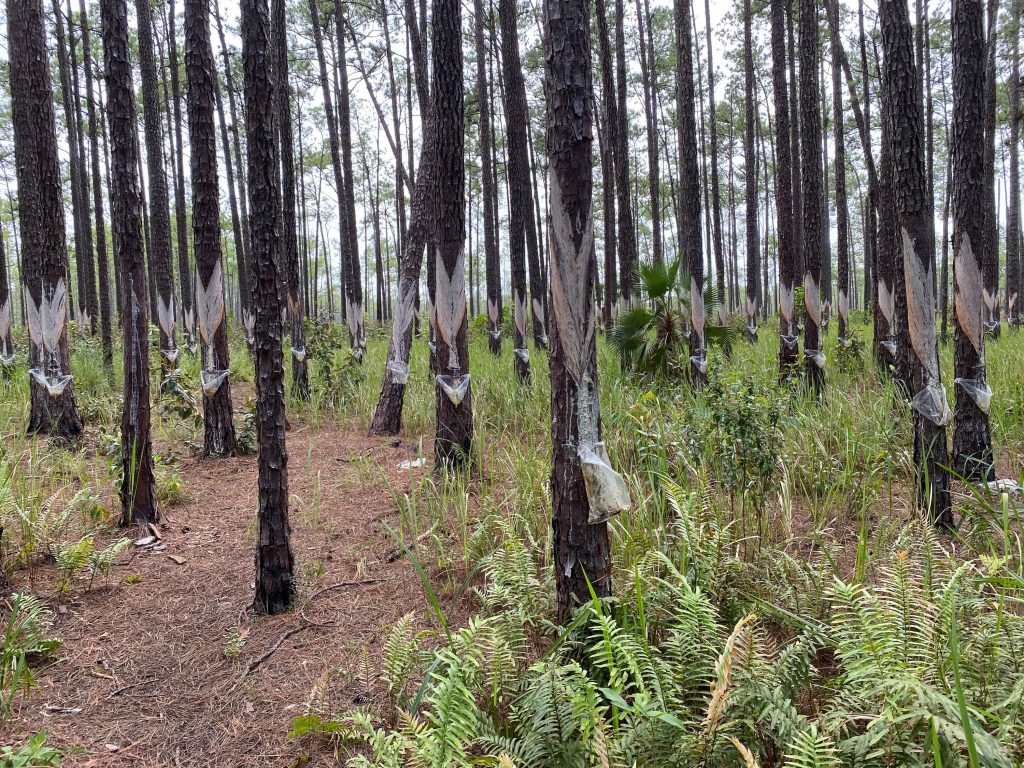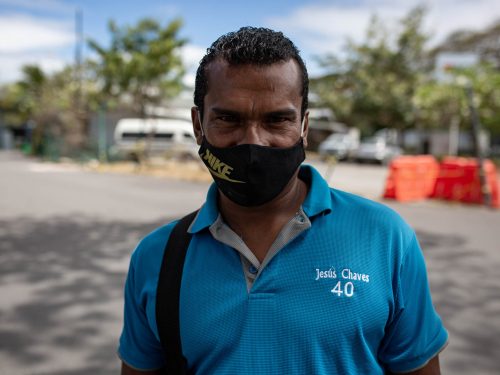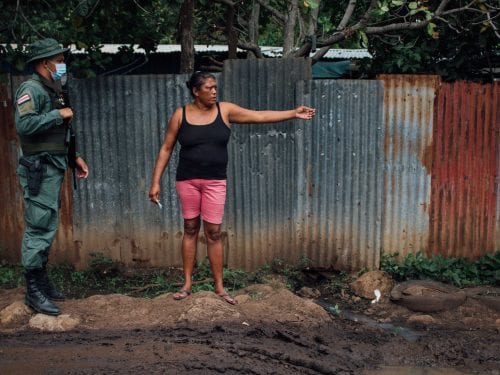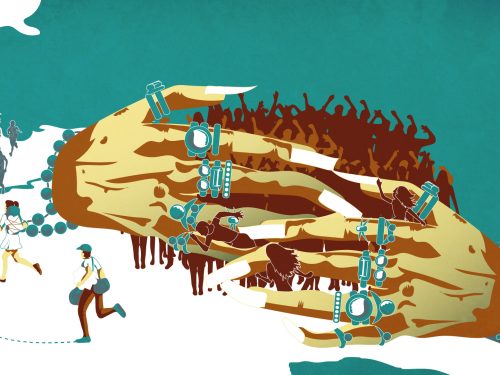
When the Nicaraguan people go to the polls this Sunday, they will find an empty ballot: after months of repression against his political opponents, the authoritarian regime of Daniel Ortega has cleaned up any serious competition that could threaten his presidency.
Since June this year, his government has detained more than 15 political figures, journalists and opposition activists. This campaign triggered a new wave of sanctions from the United States and the European Union.
But there is another parallel crisis that has not received as much attention: the role of the Ortega-Murillo regime in an environmental disaster with serious consequences on the effects of climate change.
Nicaragua is home to the second largest rainforest in the Americas after the Amazon, but it is the country that loses its forests at the fastest rate in the world. Deforestation skyrocketed in 2014, when Ortega took direct control of the National Forest Institute (Inafor), as part of a broader tactic to seize power and cement his personal control over that country.
According to Our World in Data, an initiative led by academics at Oxford University, United Nations data indicates that the average annual loss of forests in Nicaragua practically doubled in five years: it went from 1.34% between 2010-2015, 2.56% between 2015-2020.
The Organized Crime and Corruption Reporting Project (OCCRP) analyzed a massive leak of Inafor documents and showed that corruption in the institution, as well as the political intervention of the presidential family, fueled this environmental disaster.

Credit: Alam Ramírez Zelaya – OCCRPPhoto: Alam Ramírez Zelaya - OCCRP
What happened with the National Forestry Institute (Inafor)?
Inafor data shows that the first lady and vice president, Rosario Murillo, directly intervened with the institution with the help of other officials, and used it to distribute favors to companies with political connections. In addition, the documents suggest that a Supreme Court judge, who had been sanctioned by the United States, benefited from an Inafor reforestation program.
The OCCRP research also included dozens of interviews exposing how indigenous communities have been marginalized as foreign companies cut down their forests, and how basic governance and oversight functions were transformed to serve the interests of the presidential family.
The former Nicaraguan Minister of the Environment, Jaime Incer Barquero, affirmed that the illegal grabbing of indigenous lands, a key factor in deforestation, occurs with the “consent of the authorities at all levels.”
Corruption is the principal cause of all of these disgraces,” added the former minister.
A former Inafor official, who spoke anonymously for security reasons, pointed out that the agency issued forest permits following the direction of the presidency for political reasons or to companies whose true owners are unknown.
“Their role is to make it look legal, although it is not,” explained the official. “Drugs are not the only ones with a mafia; timber, too.”
A senior official from the Nicaraguan Ministry of Foreign Affairs did not respond to the questionnaire that OCCRP sent him. Murillo acknowledged having received questions from journalists, but did not answer them.
At a time when the preservation of tropical forests is central to the international strategy to stop climate change, the case of Nicaragua is a warning about how corruption can affect efforts to protect the planet. Last year, according to the NGO Global Witness, the country was the deadliest in the world per capita for those who defend their land and the environment.
“Corruption is a major driver of deforestation,” says Paulo Moutinho, scientist and co-founder of IPAM Amazônia, a Brazilian NGO that studies logging in the Amazon
“There is a sense of impunity related to environmental crimes,” Moutinho added.

Credit: OCCRP
Trees and Power
In August 2017, Ortega appointed Shanda Vanegas, a native of the autonomous region of southern Nicaragua, as co-director of Inafor. Vanegas, the first Afro-descendant woman to hold the position, wanted to eradicate corruption in that entity.
Her tenure lasted just four months.
In December of that year, Vanegas wrote an anguished letter to Vice President Murillo announcing her resignation and denouncing corruption at Inafor. In her message, she blamed “gangsters that from within” block attempts to clean up the agency.
Leaked emails show that Murillo – whom the United States Department of the Treasury described in 2018 as the “de facto co-president of Nicaragua” when it sanctioned her for corruption and human rights abuses – maintained a tight grip on Inafor, making decisions in all kinds of activities, from official reports to meeting agendas with international donors.
On one occasion, Murillo intervened to help the National Electricity Transmission Company (Enatrel), a state electricity distribution company that has been denounced for handing over contracts to the presidential family. OCCRP’s analysis of the leak reveals that Enatrel was the top recipient of forestry permits between 2014, when it received 28, and 2018, when it obtained 317.
In March 2020, Murillo approved a directive that allowed the power company to receive authorizations to cut and prune trees. The following month Inafor granted Enatrel a special type of forestry permit reserved for projects of “National Interest.” Enatrel was also the only entity in the entire Inafor leak that was exempted from paying for agency inspections.
A long chain of permits
It is not clear why Enatrel needed such a large number of forestry permits. Many requests in the leak indicate that he asked for them to expand the country’s power grid. A government plan also projected that Enatrel required a growing number of permits from Inafor for “rural electrification.”
But the most common type of permit Enatrel received was for firewood and charcoal, both widely used fuel sources in Nicaragua. Experts questioned why the state company would need these permits, since it does not generate electricity, it only transmits it.
The former Inafor official indicated that Enatrel was regularly granted permits despite not meeting “the minimum requirements” to obtain them and estimated that the company did not restore 80 percent of the areas it cleared. Spreadsheets and leaked emails list dozens of cases in which Inafor found that the state company had not restored deforested areas, despite its legal obligation.
“Enatrel has not shown evidence of having a restoration plan, much less of having applied it,” said the former Inafor official.

Osorno Coleman takes part in a political event in Waspam, Nicaragua. Credit: OCCRP
One family, many businesses
Another reason the Ortega regime may have helped Enatrel is that the company was used to funnel money to the presidential family.
In 2018 and 2019, Enatrel paid almost $ 500,000 in advertising contracts to companies run by the sons of Ortega and Murillo, according to the Latin American research platform Connectas. The contracts, which were seen by OCCRP, included an advertising company controlled by Juan Carlos Ortega, the son of the presidential couple and that the United States sanctioned in 2020 for spreading “regime propaganda.”
Ryan Berg, from the Americas Program at the Center for Strategic and International Studies, noted that Ortega and Murillo have used their “army” of nine children to ensure that the family has control of key sectors of the economy.
The revolutionary credentials have long faded,” said the specialist. “At this point it’s a family business.”
But the special deals at Inafor didn’t just favor Enatrel. Leaked emails show that Murillo also stepped in to help a pine resin company that counts Osorno Coleman among its partners. This is a former indigenous commander who fought against Ortega’s forces in Nicaragua’s civil war, but later switched sides to work with the Sandinista National Liberation Front.
Amaru Ruiz, director of the Nicaraguan environmental organization Fundación del Río, affirmed that Inafor functions as an organized crime group, with decisions that are transmitted from top to bottom in a clientelist system.
“It works like the mafia,” he said of the forestry agency. “Everything comes from the capo and the cape,” he added, referring to Ortega and Murillo.

Credit: Cristopher Mendoza – OCCRP
Aid Money Diverted?
Despite the concerns about deforestation promoted by the Nicaraguan government, international cooperation has invested millions of dollars in environmental projects in the country.
According to a count carried out by OCCRP, between 2007 – when Ortega began his second term – to November 2020, donors such as the United Nations, the World Bank and the Inter-American Development Bank approved grants, cofinancing and loans for 513 million dollars. The country also benefited from regional and international funds of about $ 3.68 billion provided by the Global Environmental Facility, which distributes financial aid from large international donors.
This international support has drawn criticism from environmentalists and groups that defend indigenous rights.
“The Nicaraguan government has shown that it cannot protect our communal lands, our forests, or our indigenous and Afro-descendant population,” wrote the Alliance of Indigenous and Afro-descendant Peoples of Nicaragua in an open letter to the UN Green Climate Fund, after it approved the $ 115 million Bio-CLIMA project in November last year.
The World Bank, which withdrew its support for the project earlier this year, citing implementation concerns, said it was “ready to support conservation projects in the future.” The Green Climate Fund did not respond to the questionnaire sent to it.
But data from the Inafor leak shows that one of Nicaragua’s main reforestation programs could also have been used to benefit an Ortega ally.

Credit: INAFOR (Nicaragua)
A National Reforestation Crusade?
An important part of the thousands of leaked emails and documents are linked to the so-called National Reforestation Crusade of Inafor, an initiative in which police, soldiers, students and volunteers plant trees throughout the country. About 250,000 hectares have reportedly been planted since they started in 2007.
The crusades are part of the National Forest Program, which receives funding from the National Forest Development Fund (FONADEFO), managed by Inafor. The fund was created in 2006 to support sustainable forest management projects with a mix of state investment, private donations and international funds, including those from the World Bank.
Nicaraguan environmentalist Fabio Buitrago indicated that these “crusades” have been used to benefit Ortega allies, by financing private plantations instead of public projects. Under Nicaraguan law, anyone who operates a forest plantation can deduct up to 100 percent of their property taxes and 50 percent of municipal taxes on the sale of land.
“It was a pretext to channel money to individuals and companies that are related to the government,” said Buitrago, of the Nicaraguan Foundation for Sustainable Development. “A good part of the money that he managed to raise did not go to reforest the public areas of the country.”
One of the beneficiaries, according to leaked Inafor data, was Marvin Ramiro Aguilar García, vice president of the Supreme Court of Justice of Nicaragua and a senior member of the Sandinista National Liberation Front. Aguilar, a close ally of Ortega and Murillo, was sanctioned by the United States last year for supporting “the identification, intimidation, and systematic punishment of the regime against the political opposition”:
A spreadsheet detailing the plantations registered for the 2018 crusade shows that Aguilar operated an Inafor plantation in San Pedro de Lovago, a municipality in the central region of Chontales, where he and Ortega were born. Other tables list dozens of parcels owned by him in Santo Tomás and Juigalpa, also in Chontales, where he received trees that year and the next.

Credit: INAFOR (Nicaragua)
Buitrago indicated that it would be illegal for Aguilar to receive benefits from Fonadefo under the rules of the fund and the Nicaraguan Constitution. For several months this journalistic team sought to find out the details of the payments and other information about the inner workings of Inafor, but the sources were too scared to speak, fearing for their safety and that of their families amid the current political repression.
Neither Aguilar nor Inafor responded to repeated messages and questionnaires that were sent to them.
All the trees that Aguilar received in San Pedro de Lovago in 2018 came from Desminic S.A., one of the largest mining companies in Nicaragua and which at that time was owned by Canada’s B2 Gold.
Like Magistrate Aguilar, Desminic operates forest plantations in Chontales, where it owns the important La Libertad mine. The project has been criticized for displacing indigenous communities and other smallholders from the area. The population affirms that the operation also causes environmental damage, such as the contamination of water sources and the death of native fauna and fish.
The data from the leak shows that Aguilar received trees from Desminic S.A. in 2018, a year after the company and the magistrate signed an agreement for the mining company to finance a government plan to improve access to justice for the inhabitants of Chontales.
Desminic S.A. He said that it is committed to preserving the environment in the areas where it operates, that it respects human rights and does not promote the displacement of indigenous communities or any sector of the population.
In a statement, the company said that its “relations with the Nicaraguan government and its officials are framed in compliance with national laws” and that it asks its workers and suppliers to follow a code of conduct. Desminic did not answer specific questions about his relationship with Aguilar.

Credit: Cristopher Mendoza – OCCRP
Ortega’s ‘Slush Fund’
In March 2019, members of an indigenous forestry company from the Autonomous Region of the North Caribbean Coast of Nicaragua wrote to Inafor to ask for help.
His cooperative, Bloque Sipbaa, was facing difficulties in obtaining logging and transporting permits for timber on its collective lands. The delays had scared away a financier and they ended up “in debt to the investor and lacking credibility as a cooperative,” the letter said.
A few years earlier, the representatives of the Sipbaa Block wrote, another company cut down the region’s forests without the approval of Inafor. That company, however, had high-level political connections.
What is Alba Forestal?
Alba Forestal, as it was called, was part of an extensive group of companies created by the late Venezuelan President Hugo Chávez to provide aid to Ortega, one of his closest allies. In 2019, the United States sanctioned this conglomerate, called Albanisa, which the US national security adviser John Bolton described as a “slush fund for the Daniel Ortega regime.”
Alba Forestal was created with the intention that rural communities – most of them indigenous – would benefit from the trees destroyed by Hurricane Felix, which devastated Nicaragua in 2007.
But in 2020 a report by the newspaper El Confidencial and Armando.info revealed that the project was actually used to cut down healthy trees and bring benefits to Albanisa. Between 2009 and 2016, Alba Forestal cut more than 12.4 million cubic meters of wood throughout Nicaragua, according to Rodrigo Obregón, a former assistant manager of the group.
“The Alba Forestal project was actually one of national deforestation,” Obregón told El Confidencial.
Another report from Connectas and the Nicaraguan media Divergentes showed that between 2012 and 2016, Alba Forestal earned almost $ 6 million from the exploitation of lands belonging to indigenous communities in the north of Nicaragua.
A spreadsheet of the Inafor leak shows that between 2011 and 2013 Alba Forestal received six permits covering two areas in Puerto Cabezas, a city near the Sipbaa Block.
Alba Forestal’s business had a devastating impact on the Sipbaa Block. Its former manager Juan Carlos Ocampo indicated that the company weakened the business model of the indigenous cooperative, forcing them to sell raw wood for a fraction of the price they received for the processed wood.
When Alba Forestal opened a road into the forest in 2007, land grabbers entered the community’s territory, seizing plots of land and cutting down trees.
“Now practically the entire area of the cooperative is in disarray,” says Mateo Ocampo, who was then president of the Sipbaa Block.
Nidia Matamoros, a former collaborator of the international environmental organization WWF who worked for several years with the Sipbaa Block, explained that the cooperative’s lands are now mostly pasture for cattle, exploited by settlers.
Environmentally, it’s a crime,” affirmed Matamoros.
“A Complete Network”
However, most deforestation in Nicaragua is not caused by state entities, but by private companies and illegal land grabbers who often pave the way for them.
The government pointed to agribusiness and livestock as the main responsible for the loss of forests. Environmentalists say that the boom in Nicaragua’s gold industry is also a growing problem, as mining projects cause deforestation and pollution, and drive violence against indigenous peoples.
Despite presenting himself as anti-deforestation – Ortega even refused to sign the Paris agreement for two years claiming that he was not going far enough – the Nicaraguan government has promoted these sectors. Between 2006 and 2017, mining concessions tripled while environmental regulations were reduced. The government even created a state-owned mining company to generate new revenue, according to Nicaraguan environmental group Centro Humboldt.
ProNicaragua, another state agency under scrutiny
The state investment agency ProNicaragua has also been criticized for offering large amounts of land for plantations and for trying to attract foreign agribusiness with the “most aggressive tax incentives in the region.” ProNicaragua is led by Laureano Ortega Murillo, another son of the presidential couple that the United States sanctioned in 2019 for engaging in “corrupt businesses.”
Mining and agribusiness also encourage land grabbing, where settlers illegally clear land that they then sell to these companies. Fabio Buitrago estimated that 80 percent of deforestation in Nicaragua is illegal, much of which, according to experts, is enabled by corrupt local officials.
The former Inafor official, who spoke with OCCRP on condition of anonymity, indicated that the central government has sought to subdue the authorities that do not abide by its will in indigenous territories. “It is a complete network, that is why control over the elected territorial authorities is guaranteed,” he said.
Incer, a former environment minister, added that local government officials also play a fundamental role in this network of environmental corruption.
“The local authorities of those municipalities and those departments are in charge of issuing permits, or turning a blind eye, or submitting to a payment to let the trucks pass,” he said.
It is a whole skein of corruption that is destroying the survival capacity of Nicaraguans and making Nicaragua a poorer country,” added the former minister.
By Sasha Chavkin, Eli Moskowitz, Nathan Jaccard, Romina Colman, María Fernanda Cruz y Daniela Castro.
Organized Crime and Corruption Reporting Project (OCCRP) is a non-profit journalistic organization founded in 2006 as a consortium of investigative journalism centers, media outlets and independent journalists operating in Eastern Europe, the Caucasus, Central Asia, Latin America and Africa. It s dedicated to investigating and reporting on organized crime and corruption in different countries.







Comments